The Surface 3 Review
by Brett Howse on May 4, 2015 9:00 AM ESTDisplay
When Surface Pro 3 moved to a 3:2 aspect ratio, it made a lot of sense. 16:9 in a tablet makes for a very poor experience, and in a laptop, it is not much better. Almost everyone has moved to 16:9 in the laptop space and the lack of vertical height can make for a less than ideal experience. Most web content is vertical, and working in Office means you want vertical space as well. The widescreen does help with two windows snapped open at once, but I always find myself craving more vertical room.
On a tablet, I feel that 16:9 is even worse. Holding a 16:9 device in one hand can feel very heavy due to the length of the tablet, and turning it to portrait means that it is very tall and skinny. The move to 3:2 really squares up the device, and makes it a lot more balanced in either direction. Holding it in one hand is much easier, and finally portrait mode is usable on the Surface.
So the aspect ratio is a big improvement. The display size also has a slightly wider corner to corner of 10.8 inches versus 10.6 inch model that came before this. The actual width of the display is about 9 inches, compared to 9.2 on the outgoing Surface 2 model. The display height is now 6 inches, up from 5.2, so the total area of the display is almost 54 square inches, up from 48 inches on the outgoing model.
To fill this display, we have a Panasonic panel with a resolution of 1920x1280. This is roughly the same pixel density as the Surface Pro 3’s slightly larger 12 inch 2160x1440 display, coming in at 217 pixels per inch. It is not the highest PPI of a tablet, but it makes a good compromise between desktop and tablet use. Speaking of desktop use, I found that it makes a perfectly acceptable size for a small notebook, and even with touch it was not too difficult to work with the icons.
When Microsoft launched Surface 3, it said “with incredibly accurate colors and clarity from multiple viewing angles” and that would be excellent to see. The Surface Pro 3 has a decent display, but it was not the most accurate device we’ve tested.
To do our display testing, we use SpectraCal’s CalMAN 5 suite with a custom workflow. Brightness and contrast readings are taken with an X-Rite i1Display Pro colorimeter, and color accuracy is measured with an X-Rite i1Pro spectrophotometer. We target 200 nits brightness when doing our tests.
Brightness and Contrast
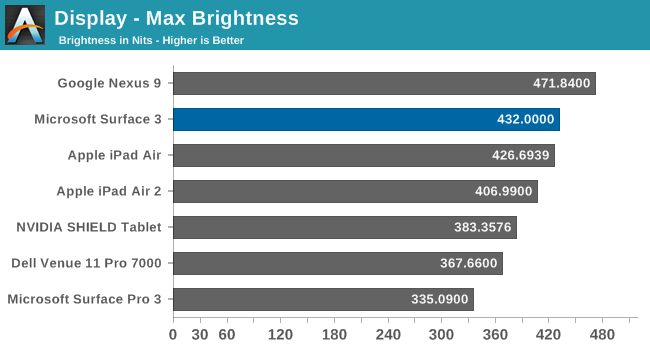
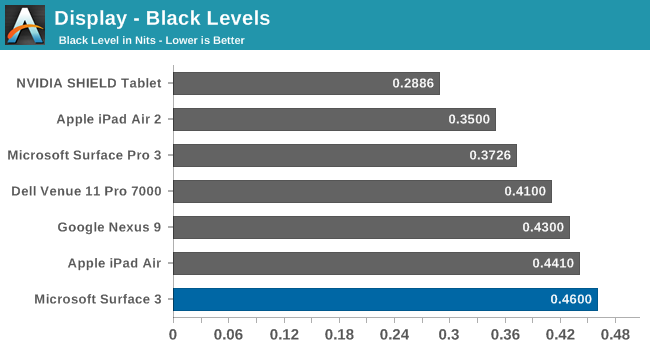
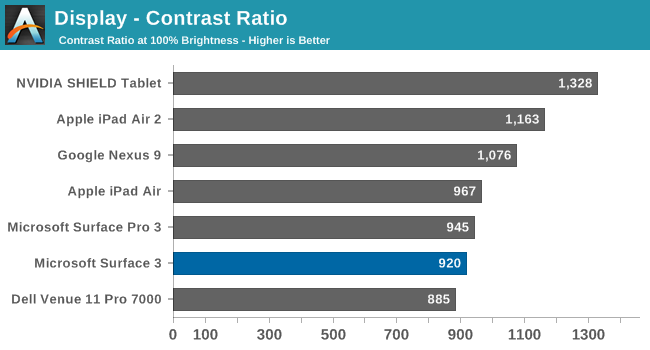
The Surface 3 gets quite bright, coming in at 432 nits at maximum output. The black levels are a bit high, but overall contrast is a decent 920:1. This makes the Surface 3 almost 100 nits higher than the Surface Pro 3 that Anand reviewed last year, which is a good start for this less expensive version.
Grayscale
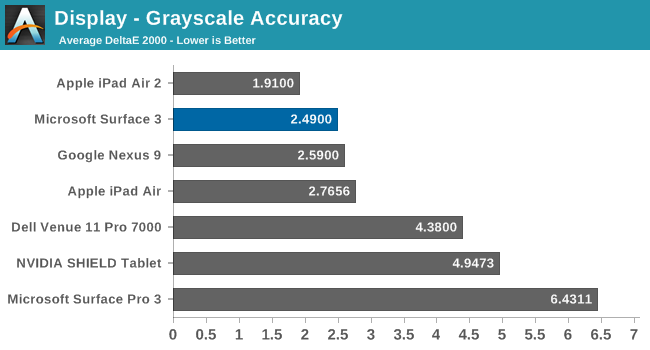
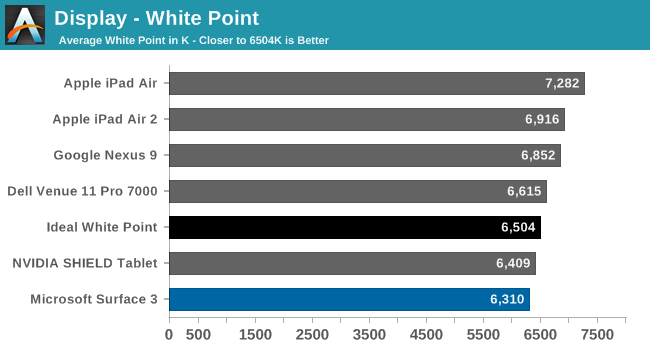
The grayscale average for the Surface 3 is very good, coming in just about at 2.5 as an average for the sweep. There is a bit of a spike at 25% but it is not indicative of the overall calibration. Gamma is a bit low, but the white point is fairly close to the ideal value.
Saturation
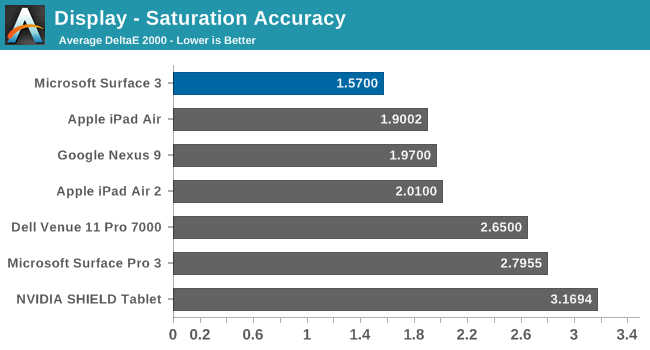
The accuracy on our saturation tests is outstanding, with an overall average score of just 1.57. Looking at the individual colors, the red is a bit oversaturated at 100%, and blue tends to be undersaturated, but the amount of error is very small.
Gamut and Gretag Macbeth
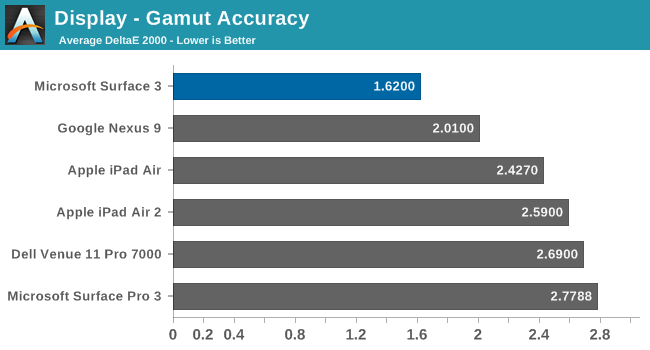
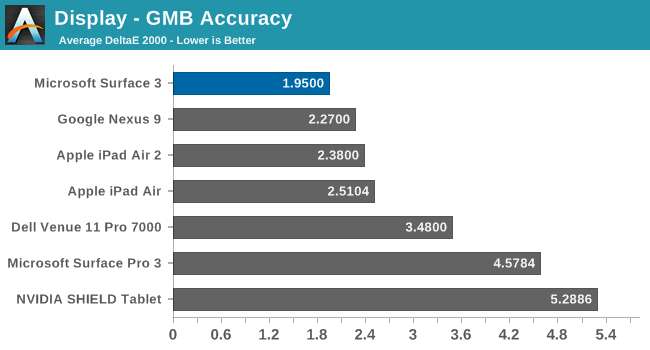
Once again the Surface 3 comes in with fantastic scores on these two tests, with the comprehensive GMB test under 2. When we are doing these tests, values under 3 are considered good, and the Surface 3 has passed with amazing scores. The best part of this is that all of this is done without the use of an ICC profile, so that means the hardware is being calibrated directly. ICC profiles can fix some issues, but not all programs respect them so having it done in hardware is a much better option.
Calibrated
Since this is a full x86 Windows operating system, we can also calibrate the display with the CalMAN software. Even though it was very good out of the box, the calibration pulls it even closer to perfection.
Surface 3 has one of the most accurate displays we have ever tested, which is great to see in what is considered the value member of the Surface family. Microsoft promised an accurate display and they have delivered.


















265 Comments
View All Comments
MrTetts - Tuesday, May 5, 2015 - link
The IPad is ALWAYS going to be an inferior product regardless of use case.1. For video/media consumption - you would have access to more media players, more content markets (than just the itunes store) and simply more choice overall.
2. For media/content creation - You do not even have this option (or intergrated well enough) on an IPad.
3. Basic office duties - We can all agree that any office applications on an IPad would be very watered down and frankly quite useless. If you have to buy a keyboard to access an application properly on an ipad, then my friend, I have news for you... your use case clearly aligns you to a surface 3.
An IPad is no where near up to par. You are getting a very big IPod Touch for your money. Don't give in to the marketing from Apple telling you you can be productive on an IPad.
zhenya00 - Tuesday, May 5, 2015 - link
No, just no. I could make a list 3 times as long as yours detailing the ways that an iPad is superior to any Windows tablet. And I own several iPads and two Surface Pros. Frankly I'm just tired of having to counteract this kind of FUD.romprak - Tuesday, May 5, 2015 - link
I have 3 iPads at home (first gen, 3rd gen, and Air) - and his list seems quite accurate to me. One reason I've started transitioning our children after they are 6 years old to Surfaces and/or Macs. I am a little sad at how much money we've wasted on iPads, I certainly will not be doing that any longer.With our Macs and Surfaces, the children are actually learning how to do stuff and not be passive observers.
lolstebbo - Tuesday, May 5, 2015 - link
The only mental block I'm having right now is does Microsoft even have some sort of equivalent to iMovie? That's the one thing on the Mac side that I don't have a Windows-compatible equivalent for.lilmoe - Monday, May 4, 2015 - link
Better performance is arguable. Your mileage may very when it comes to battery life too. It's not only about the keyboard, it's what you can do with that keyboard (IE: iOS VS full Windows, and there's not comparison there). With Windows 10, it's practically game over when it comes to value.It's the other way around. The iPad, and other Android tablets (I'm looking at you Samsung), should be priced way less if we're talking "value".
pedromcm.pm - Monday, May 4, 2015 - link
No. The iPad has better screen, apps designed for that screen, a much superior touch-based ecosystem, better SoC performance, 4g option, better battery life and so on. And people buy it because it doesn't run windows, too... It runs something else that is fun, simpler, and does the job, most of the time.Still, i hope that with force touch Apple brings a superior pen-based solution. Because of the mentioned qualities, if the iPad adds what is seen as the surface and note line greatest advantages, it will be the equivalent of iPhones and bigger screens.
ultrAV - Monday, May 4, 2015 - link
"apps designed for that scren" what do u mean, are you compare ios to android tablet?4g option is available for surface 3 too
BlueBomberTurbo - Monday, May 4, 2015 - link
Better screen? Might want to read over the Display section again...Considering the lightweight OS, it's no wonder the iPad has better performance. Try running OS X on there and see what happens.
The Surface 3 will also have a 4G option soon, just not at launch.
And Windows 10 will be able to run fun and simpler apps from iOS and Android, and apps that always get the job done from Windows. ;)
pSupaNova - Monday, May 4, 2015 - link
Please guys this tablet can not compare itself to an IPad or Android in the tablet space.Simple things like finding good replacement soft keyboards are severly lacking in the Metro store.
The performance of the atom is getting better as the GPU has vastly improved but cannot still match last years top tablets.
As for Full windows use your better off just getting a laptop, the included digitizer is a very good addition but thats a niche field at best.
Microsoft need to drastically lower the price of this tablet if they want it too succeed or throw in the touch cover and pen.
And trying to intice Android and IOS developers is just showing how lacking Windows store is.
Lesliestandifer - Monday, May 4, 2015 - link
I have an iPad can't really compare windows to iOS or android. When I want do some reading in bed I reach for my tablet when I want to do some real work I get my pc. Both iOS and android flourished because they were cheap quick n easy and there was really no Windows alternative with equivalent specs and power. No one said the windows store was awesome I also had a windows phone it sucks.tablets have always left me wanting to be able to do more. iPads are significantly underpowered and still don't multitask properly! Now with the opportunity to get rid of the iPad\laptop and run it from one device ....yes I will be doing that when the SP4 comes out.